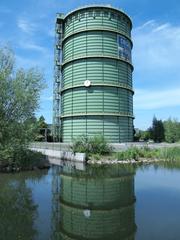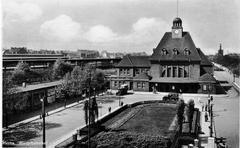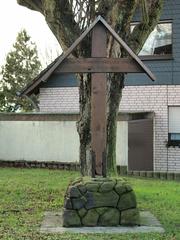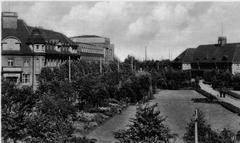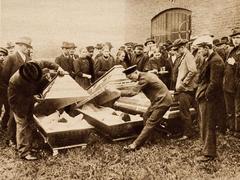Siedlung Teutoburgia Herne, Germany: Visiting Hours, Tickets, and Historical Sites Guide
Date: 03/07/2025
Introduction
Siedlung Teutoburgia, located in Herne, Germany, is a celebrated example of early 20th-century industrial heritage and innovative urban planning. Developed between 1909 and 1923 alongside the Teutoburgia colliery, the estate embodies the ideals of the Garden City movement—offering functional, aesthetically pleasing housing amid abundant green spaces for coal miners and their families. Its preserved street layout, diverse architectural styles, and remaining industrial landmarks, such as the iconic shaft headframe, offer visitors a compelling window into the Ruhrgebiet’s coal mining history and social development (route-industriekultur.ruhr, herne.de).
Today, Siedlung Teutoburgia stands as both a tranquil residential quarter and a vibrant hub for cultural events, contemporary art, and community engagement. This guide provides comprehensive information on the estate’s history, visiting hours, accessibility, guided tours, and nearby attractions, equipping you for a rewarding visit to one of Germany’s most remarkable industrial heritage sites.
Table of Contents
- Historical Background
- Visiting Siedlung Teutoburgia
- Frequently Asked Questions (FAQ)
- Visuals and Interactive Elements
- Summary and Recommendations
- Sources and Further Reading
Historical Background
Origins and Planning (1907–1923)
Siedlung Teutoburgia was conceived as a residential estate for the workers and officials of the newly established Teutoburgia coal mine. Initiated in 1907 by the Bochumer Verein für Bergbau und Gussstahlfabrikation, the project began with the acquisition of land and the construction of both the mine and settlement (dfrg-bochum.de). Designed by architect Otto Berndt, the estate drew inspiration from the English Garden City movement, focusing on the integration of green spaces, individualized homes, and a high standard of living for residents (herne.de PDF). By 1923, the estate comprised 136 buildings with over 450 apartments (route-industriekultur.ruhr).
Architecture and Social Structure
Teutoburgia’s architecture reflects both social hierarchy and community ideals. Four principal house types were used, with varied facades to create visual diversity and avoid monotony. Workers’ houses, found mainly on Baarestraße and Laubenstraße, were modest yet dignified, while larger, more ornate homes for officials lined Schadeburgstraße. After World War I, the Teutoburgiahof courtyard block was added to provide denser, affordable housing (dfrg-bochum.de). Generous gardens, tree-lined avenues, and communal courtyards fostered wellbeing and social interaction (herne.de PDF).
Life in the Settlement and Industrial Context
The estate housed miners and their families, providing improved living standards compared to traditional, crowded tenements. Distinct architectural typologies mirrored social status, while gardens and courtyards enhanced daily life and community spirit (dfrg-bochum.de).
Decline and Transformation (1925–1980s)
The Teutoburgia colliery ceased operations in 1925, and the estate’s purpose evolved. During World War II, mining briefly resumed, and a forced labor camp was established. Despite wartime challenges, most of the estate’s buildings survived. In the 1980s, VEBA Wohnen AG secured permanent tenancy rights and initiated an award-winning modernization and restoration program (route-industriekultur.ruhr).
Preservation and Monument Protection
Inclusion in the Internationale Bauausstellung (IBA) Emscher Park in the late 1980s marked a turning point for the estate’s conservation. Restoration efforts preserved its historic character while updating infrastructure. Monument protection status was granted in 1992, ensuring the continued safeguarding of both buildings and gardens (herne.de PDF).
Colliery Site and Kunstwald
Most colliery structures were demolished in the 1980s, except for the Shaft 1 headframe and machine hall. The former industrial site now features the Kunstwald (“Art Forest”), an open-air exhibition space for contemporary art, sculpture, and light installations—a creative reuse that connects the area’s industrial past with its cultural present (route-industriekultur.ruhr).
Sustainability and Community Recognition
Since 1991, a combined heat and power plant has supplied the estate with sustainable energy sourced from mine gas, with the initiative expected to continue at least until 2031 (Vonovia press release). Siedlung Teutoburgia is widely recognized for its exemplary preservation, earning awards and drawing attention from historians, architects, and cultural tourists (herne.de).
Visiting Siedlung Teutoburgia
Visiting Hours and Admission
- Open-Air Access: The estate is an open residential area accessible year-round, 24 hours a day. There is no entrance fee for walking its streets and green spaces.
- Guided Tours & Special Venues: Some guided tours and special events require tickets and have set times; check the official Herne tourism website or Förderverein Teutoburgia for current schedules.
Accessibility and Directions
- Public Transport: Siedlung Teutoburgia is easily reached from Herne Hauptbahnhof by bus lines 311 or 312; the “Herne Börnig Siedlung” stop is a short walk from the main avenues (Ruhr Tourismus).
- By Car: Limited parking is available near Baarestraße and Schadeburgstraße.
- On Foot/Bike: The area is pedestrian- and bicycle-friendly, with paved paths and bike racks.
Guided Tours and Events
- Guided Tours: Offered by heritage organizations such as Förderverein Teutoburgia, tours typically last 60–90 minutes and include in-depth historical and architectural commentary (Stadt Herne).
- Self-Guided Exploration: Informational panels in German and English, as well as downloadable audio guides and maps, are available via the Route Industriekultur website.
- Cultural Events: The estate hosts regular events, including art festivals, open-air exhibitions in the Kunstwald, and community markets.
Architectural Highlights
- Baarestraße: The main avenue, offering views toward the preserved pit frame and original miners’ houses.
- Laubenstraße: Home to early workers’ residences.
- Schadeburgstraße: Features officials’ houses with more elaborate architecture.
- Teutoburgiahof: A post-WWI courtyard block, reflecting changes in housing design and social structure.
- Kunstwald: An open-air art park with contemporary sculptures and installations (Skulpturenpark Teutoburgia).
Visitor Amenities
- Restrooms: Public facilities are located near the main entrance and cultural center.
- Café: A historic building houses a café serving regional snacks and coffee.
- Information Center: Brochures, maps, and souvenirs are available on weekends and during events.
- Wi-Fi and Charging: Free Wi-Fi and charging stations for e-bikes and mobile devices are provided in central areas.
- Family-Friendly: Stroller-friendly routes and a playground are available for visitors with children.
Sustainability and Community Engagement
Siedlung Teutoburgia is a model for sustainable tourism, with restoration projects emphasizing eco-friendly materials and energy efficiency. The local community actively participates in site maintenance and cultural programming (Herne Stadtentwicklung). Visitors are asked to respect the privacy of residents and use designated facilities.
Nearby Attractions
- Zeche Teutoburgia: The former mine, now a museum and event venue (LWL-Industriemuseum).
- Gysenbergpark: Urban park with walking trails, thermal spa, and recreation (approx. 3 km away).
- Route der Industriekultur: Siedlung Teutoburgia is a highlight on this regional heritage route (Route Industriekultur).
- Akademie Mont-Cenis: Notable architectural and cultural site nearby.
- Schloss Bladenhorst: A historic castle within easy reach.
Frequently Asked Questions (FAQ)
Q: What are the visiting hours for Siedlung Teutoburgia?
A: The estate is open to the public daily, 24 hours a day, as an open-air residential area. Guided tours and special venues may have set hours.
Q: Is there an entrance fee?
A: No, general access is free. Fees may apply for guided tours and special exhibitions.
Q: Are guided tours available in English?
A: Most tours are in German, but English tours can be arranged during peak seasons or by prior request.
Q: Is the estate accessible for visitors with limited mobility?
A: Most paths are paved and accessible, though some older areas may have uneven surfaces. Contact visitor services for detailed accessibility support.
Q: Are there amenities for families?
A: Yes, stroller-friendly routes and a playground are provided.
Q: Can I take photos?
A: Photography is welcome throughout the estate; drone use requires prior permission.
Visuals and Interactive Elements
Explore interactive maps, downloadable audio guides, and high-quality photographs of Siedlung Teutoburgia via the official website. Images are provided with descriptive alt text such as “Siedlung Teutoburgia historic houses,” “Herne industrial heritage,” and “Kunstwald art installation” to enhance accessibility.
Summary and Visitor Recommendations
Siedlung Teutoburgia in Herne is a model of successful heritage preservation and adaptive reuse, seamlessly blending its industrial past with contemporary culture and community life. Its thoughtfully designed architecture, lush green spaces, and vibrant event calendar make it a must-visit for history buffs, architecture enthusiasts, and families alike. The estate’s ongoing commitment to sustainability and resident engagement ensures its continued vitality as a cultural destination. Plan your visit with the help of online resources, guided tours, and mobile apps like Audiala to make the most of your experience (herne.de, route-industriekultur.ruhr).
Sources and Further Reading
- Die Bergarbeitersiedlung Teutoburgia in Herne, 2024, Deutsche Fördergemeinschaft für Regionalgeschichte
- Zechensiedlung Teutoburgia, 2024, Route der Industriekultur Ruhr
- Teutoburgia Gestaltungshandbuch, 2017, Stadt Herne
- Teutoburgia Siedlung – Herne, 2024, Stadt Herne Kultur und Freizeit
- Ruhr Tourismus – Zechensiedlung Teutoburgia, 2024
- Förderverein Teutoburgia, 2024
- Teutoburgia Settlement and Energy Use, 2019, Vonovia Press Release
- Skulpturenpark Teutoburgia, 2024
- Tag des offenen Denkmals, 2024, Deutsche Stiftung Denkmalschutz
- LWL-Industriemuseum – Zeche Teutoburgia, 2024
- Ruhr Guide – Siedlung Teutoburgia, 2024
